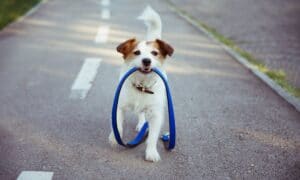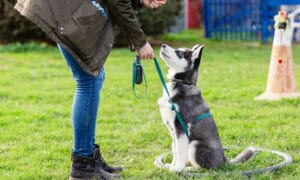“This post contains affiliate links, and I will be compensated if you make a purchase after clicking on my links.”
Corrections are quantum, and more importantly they are non- instructive. Leash correction, electric collars or other tools used to punish are non- instructive. It doesn’t tell the dog what it should do instead of. People were correcting their pets yet they never seemed to be thinking anything about it because this is what they were told and taught to do so it must be okay.
What happens with dogs when you train like this? Maybe forty percent of dogs do fine, if they have a strong temperament and bodies, but maybe thirty percent do not. Ten percent may bite you, and ten percent may shut down and express their anal glands.
Training from the outside-in rather than from the inside-out was developed for companion dog training right out of WWII. Training is a mind game and not a physical one.
Training is essentially an art and a science. Now, there are many trainers, but there are not so many artists. An artist requires a special skill set, plenty of hands on practice and with different species as well as flexible and adaptable training techniques.
After my one obedience dog, I quit obedience competitions. But still carried this intense desire to train. I then took a different road to animal training. I began to study ” B.F. Skinner” students the “Brelands” who trained over 140 species. I read and studied just about every book on the subject of animal training and their behavior. Though my favorite’s students are dogs, I trained cats, fish, and a pot belly pig and yes a chicken at Bob Baily’s chicken camp.
Training different species really sharpens your mind, your creativity, your timing, your eyes, your outlook and it instills just how behaviors are learned.
I’m happy to say that today’s training is based on developing a working relationship built on cooperation and mutual respect that will motivate you to want to train your dog, and will motivate your dog to want to train with you. I must acknowledge the one good detail we learned from military style training was how to handle a dog because it was all based on handling your dog which is something that is lacking in today’s training.
Training and learning is a mental process, rather than a physical one. Let’s use our brains to teach dogs to use their brains. What is training? Training is really about putting behaviors on a verbal cue. The old training jargon was “command” which impressed on pet owners; the dog had to do it now!
We still want our dogs to respond now, only now we understand that they are not robots, they are not our slaves and that many factors can be impeding the immediacy.
They are beings with five senses, they have wants and needs, they have emotions, they get distracted, they want 30 more seconds to chase that squirrel, they are engrossed in something, haven’t we all been engrossed in something and failed to respond to someone?
By using compulsion you’re showing your dog that your temperament can’t be trusted and only trains your dog not to like working with you and not like you. You will feel better about training and find yourself less likely to get angry with your dog. We have human brains, using science based applications will reap the success you’re looking for without damaging the dog/human bond. Why would I get a dog to make its life miserable when I can accomplish so much more using humane methods and providing feed-back?
In my mind training a dog is on par with romance, love and something beautiful. It’s an absolute myth that painful punishment is necessary, and it’s an absolute myth that you need to have endless reinforcement schedules to get to reliability. That’s not the pet, but the pet owner is not consistent.
Teaching our dogs to accept different forms of reinforcement such as praise, petting, tennis balls, games, food, and play. As well as providing training exercises that a pet owner finds useful. We need to teach loose leash walking, teach dogs to settle on a mat, teach them how to relax and be calm teach them to come when called.
Teach owners that it’s okay for the dog to sniff when out walking, sniffing with rules and structure is okay, denying a dog to use his nose on a walk is unkind; give your dog time to do this. Take a few breaks when walking allowing your dog to take in the environment. We trainers need to teach owners how to play with their dogs, for that is the thing dogs love the most, a time to share craziness with you, to rumble, to chase, to hear you laugh or to just walk with you, to use up some of his mental energy.
The stay exercise – how many owners tell their dog to stay and walk away? None that I’ve met. Better to teach your dog how to wait for you calmly while being safely hitched to a post when you go quickly into a store. Think of the reason why you have your dog, why you decided a dog would fit in your life. If you have forgotten, revisit your reasons and then apply them.
At heart we are all dog lovers, so why anyone who loves would dogs cause anxiety or discomfort to that dog? The only reason I can think of is that their instructor has convinced them of this fact; tradition still has followers in the year 2013.
“Violence begins where knowledge ends”. We now have the knowledge in us to know how to create understanding in dogs with peaceful, harmonious effective methods. Remembering that each and every dog is an individual.
For even more training and behavior tips, visit The Pee Press!



















Riverdivine
Feb 14, 2013 at 12:32 pm
Thanks for the good article- I particularly liked learning about the history of dog trainers in the past several decades. When I adopted my dog (who came with a range of behavioral issues/challenges), I found the books of Dr.Patricia McConnell, Humane Dog Trainer/Animal Behavioralist, invaluable! (My dog no longer has these issues, and was never traumatized in the process of learning more adaptive behaviors.. :)) Lets keep it positive for everyone.